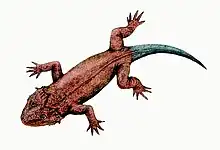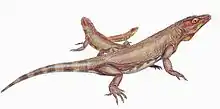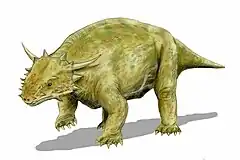| Lanthanosuchoids Temporal range: Late Carboniferous - Late Permian, | |
|---|---|
 | |
| Restoration of Lanthanosuchus watsoni | |
| Scientific classification | |
| Domain: | Eukaryota |
| Kingdom: | Animalia |
| Phylum: | Chordata |
| Class: | Reptilia |
| Clade: | †Parareptilia |
| Order: | †Procolophonomorpha |
| Node: | †Ankyramorpha |
| Superfamily: | †Lanthanosuchoidea Ivachnenko, 1980 |
| Subgroups | |
Lanthanosuchoidea is an extinct superfamily of ankyramorph parareptiles from the middle Pennsylvanian to the middle Guadalupian epoch (Moscovian[1] - Wordian stages) of Europe, North America and Asia.[2] It was named by the Russian paleontologist Ivachnenko in 1980, and it contains two families Acleistorhinidae and Lanthanosuchidae.[3]
Phylogeny
Lanthanosuchoidea is a node-based taxon defined in 1997 as "the most recent common ancestor of Lanthanosuchus, Lanthaniscus, and Acleistorhinus".[3] The cladogram below follows the topology from a 2011 analysis by Ruta et al.[2]
| Lanthanosuchoidea |
| ||||||||||||||||||
The cladogram below follows the topology from a 2016 analysis by MacDougall et al.[4]
| Lanthanosuchoidea |
| ||||||||||||||||||||||||||||||
However, the phylogenetic analysis conducted by Cisneros et al. (2021) did not recover a clade uniting lanthanosuchids and acleistorhinids to the exclusion of all other parareptiles. Instead, acleistorhinids were recovered as the sister group of the clade Procolophonia, while lanthanosuchids were recovered within the procolophonian subgroup Pareiasauromorpha.[5]
References
- ↑ Arjan Mann; Emily J. McDaniel; Emily R. McColville; Hillary C. Maddin (2019). "Carbonodraco lundi gen et sp. nov., the oldest parareptile, from Linton, Ohio, and new insights into the early radiation of reptiles". Royal Society Open Science. 6 (11): Article ID 191191. doi:10.1098/rsos.191191. PMC 6894558. PMID 31827854.
- 1 2 Marcello Ruta; Juan C. Cisneros; Torsten Liebrect; Linda A. Tsuji; Johannes Muller (2011). "Amniotes through major biological crises: faunal turnover among Parareptiles and the end-Permian mass extinction". Palaeontology. 54 (5): 1117–1137. doi:10.1111/j.1475-4983.2011.01051.x. S2CID 83693335.
- 1 2 DeBraga, M.; Rieppel, O. (1997). "Reptile phylogeny and the interrelationships of turtles". Zoological Journal of the Linnean Society. 120 (3): 281–354. doi:10.1111/j.1096-3642.1997.tb01280.x.
- ↑ MacDougall, M.J.; Modesto, S. P.; Reisz, R. R. (2016). "A new reptile from the Richards Spur Locality, Oklahoma, USA, and patterns of Early Permian parareptile diversification". Journal of Vertebrate Paleontology. 36 (5): e1179641. doi:10.1080/02724634.2016.1179641. S2CID 89333948.
- ↑ Cisneros, J. C.; Kammerer, C. F.; Angielczyk, K. D.; Fröbisch, J.; Marsicano, C.; Smith, R. M. H.; Richter, M. (2021). "A new reptile from the lower Permian of Brazil (Karutia fortunata gen. et sp. nov.) and the interrelationships of Parareptilia". Journal of Systematic Palaeontology. 18 (23): 1939–1959. doi:10.1080/14772019.2020.1863487. S2CID 231741612.





